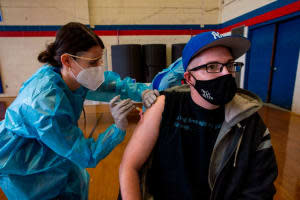It's looking less likely the U.S. will hit Biden's July 4 vaccine goal
- Oops!Something went wrong.Please try again later.
- Oops!Something went wrong.Please try again later.

President Biden has said he wants to see 70 percent of American adults at least partially vaccinated by July 4, but for this to happen, roughly 16 million people have to receive their first dose in the next few weeks, The Associated Press reports.
Two months ago, almost 2 million people were getting vaccinated per day, and that has since dropped to 400,000 a day. In 14 states, at least 70 percent of adults have had at least one vaccine, and 12 other states are on track to hit this target by July 4. Jeff Zients, the White House COVID-19 coordinator, asked governors in a conference call Tuesday to pull "out all the stops" to increase vaccinations in June. "We need your leadership on the ground — which is where it matters the most — more than ever," he said.
In Mississippi, only 34 percent of the population is vaccinated, and Gov. Tate Reeves (R) called Biden's 70 percent goal "arbitrary, to say the least." With vaccination rates as low as they are in the state, it would take almost an entire year for Mississippi to reach a 70 percent vaccination rate, AP reports. On Sunday, Reeves told CNN he wants people to get vaccinated, but it's more important that cases are dropping in the state.
There are still concerns over variants spreading in the United States, like the Delta variant that surged in India and is now the dominant strain in the United Kingdom. It's believed to be deadlier and able to spread faster, and such variants are one of the reasons why more Americans need to get vaccinated, public health experts say. Incentives have been shown to work — in Ohio, after Gov. Mike DeWine (R) announced a $1 million lottery for vaccinated adults, there was a 43 percent increase in the number of vaccinations in the state. That was only temporary, though, and the numbers were down a week later.
